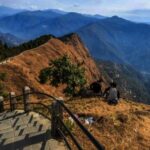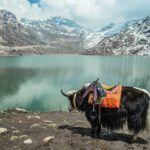WELCOME TO SIKKIM
Exploring the Beauty of Sikkim: A Paradise in the Himalayas
Sikkim, a small yet mesmerizing state in northeastern India, is a land of enchanting landscapes, vibrant culture, and unparalleled tranquility. Nestled in the lap of the mighty Himalayas, Sikkim is a haven for nature enthusiasts, adventure seekers, and anyone looking to escape the chaos of urban life. This article delves into the various facets of Sikkim, highlighting its natural beauty, cultural heritage, and tourist attractions.
Introduction to Sikkim
Sikkim, India’s second smallest state, is bordered by Tibet to the north, Bhutan to the east, Nepal to the west, and the Indian state of West Bengal to the south. Despite its modest size, Sikkim boasts a rich biodiversity and a diverse cultural tapestry. With Gangtok as its capital, Sikkim is home to some of the world’s highest peaks, including the majestic Mount Kanchenjunga, the third-highest mountain on Earth.
Natural Wonders of Sikkim
1. Scenic Mountains and Valleys
Sikkim’s landscape is dominated by towering mountains, verdant valleys, and sparkling rivers. The Kanchenjunga range, often shrouded in mist, offers breathtaking views. Treks to places like the Dzongri La and Goechala provide stunning vistas of the snow-capped peaks.
2. Pristine Lakes
The lakes in Sikkim are an embodiment of serenity. The most famous is Tsomgo Lake, located 38 km from Gangtok, surrounded by steep mountain ranges. Another notable lake is Gurudongmar Lake, one of the highest lakes in the world, revered by both Hindus and Buddhists.
3. Rivers and Waterfalls
The Teesta and Rangeet rivers meander through the state, offering opportunities for activities like river rafting. Sikkim is also home to stunning waterfalls such as the Seven Sisters Waterfall, Banjhakri Falls, and Kanchenjunga Falls, each adding to the state’s natural allure.
Cultural Heritage of Sikkim
1. Festivals and Celebrations
Sikkim is a cultural mosaic, with influences from Tibetan Buddhism, Hinduism, and local traditions. The state celebrates numerous festivals, such as Losar (Tibetan New Year), Saga Dawa, and Dasain, reflecting its diverse heritage. These festivals are often accompanied by traditional music, dance, and elaborate rituals.
2. Traditional Cuisine
Sikkimese cuisine is a delightful blend of Tibetan, Nepalese, and Indian flavors. Dishes like momos, thukpa, and gundruk are popular among locals and visitors alike. The use of local ingredients, including fermented bamboo shoots and Sikkimese cheese, adds a unique touch to their food.
3. Monasteries and Spiritual Sites
Sikkim is dotted with ancient monasteries that serve as spiritual centers. The Rumtek Monastery, one of the most significant centers of Tibetan Buddhism, and the Pemayangtse Monastery, known for its intricate architecture, are must-visit sites. The annual Chaam dance, performed in monasteries, showcases the spiritual depth of the region.
Top Tourist Attractions in Sikkim
1. Gangtok
Gangtok, the capital of Sikkim, is a bustling town offering a mix of natural beauty and urban charm. Popular attractions include the MG Marg, Tashi Viewpoint, and the Namgyal Institute of Tibetology, which houses a vast collection of Buddhist artifacts.
2. Nathula Pass
Located at an altitude of 14,140 feet, Nathula Pass is a historic trade route connecting India and Tibet. Visitors can witness the Indo-China border and enjoy panoramic views of the surrounding mountains.
3. Yumthang Valley
Known as the “Valley of Flowers,” Yumthang Valley is a floral paradise. During spring, the valley comes alive with blooming rhododendrons, making it a sight to behold.
4. Pelling
Pelling is a quaint town offering stunning views of Mount Kanchenjunga. Attractions include the Pemayangtse Monastery, Rabdentse Ruins, and the recently inaugurated Sky Walk.
5. Zuluk
A lesser-known gem, Zuluk is a small village located on the Old Silk Route. Its famous winding roads and the panoramic sunrise view over the Kanchenjunga make it a must-visit.
Adventure Activities in Sikkim
Sikkim is an adventurer’s paradise, offering a plethora of activities:
- Trekking: Trails like the Goechala trek and the Sandakphu trek are popular among trekking enthusiasts.
- River Rafting: The Teesta River offers thrilling white-water rafting experiences.
- Paragliding: Gangtok provides opportunities for paragliding, allowing you to soar above the scenic landscapes.
- Mountain Biking: The rugged terrain of Sikkim is perfect for mountain biking, with routes that traverse through forests and villages.
Biodiversity and Conservation
Sikkim is a biodiversity hotspot, with over 4,500 species of flowering plants, 144 species of mammals, and 550 species of birds. The state is home to rare species such as the red panda, snow leopard, and Himalayan black bear. To protect its environment, Sikkim has undertaken various initiatives, including banning plastic bags and promoting organic farming.
Best Time to Visit Sikkim
The ideal time to visit Sikkim depends on the purpose of your visit:
- Spring (March to May): Perfect for witnessing blooming rhododendrons and orchids.
- Summer (June to September): Suitable for trekking and exploring the lush greenery.
- Autumn (October to November): Offers clear skies and pleasant weather.
- Winter (December to February): Ideal for enjoying snowfall in places like Lachung and Lachen.
How to Reach Sikkim
- By Air: The nearest airport is Bagdogra, located in West Bengal. From Bagdogra, you can hire a taxi to reach Sikkim.
- By Rail: The closest railway station is New Jalpaiguri (NJP), which connects to major cities across India.
- By Road: Sikkim is well-connected to neighboring states by road. Regular bus and taxi services operate between Gangtok and cities like Siliguri and Darjeeling.
Sustainable Tourism in Sikkim
Sikkim has been a pioneer in promoting sustainable tourism. The state has implemented eco-friendly practices, such as waste management and community-based tourism, to preserve its natural beauty. Homestays and guided tours organized by local communities provide travelers with authentic experiences while supporting the local economy.
Conclusion
Sikkim, with its breathtaking landscapes, rich cultural heritage, and warm hospitality, is a destination that leaves a lasting impression on every traveler. Whether you are seeking spiritual solace, thrilling adventures, or simply a break from the monotony of daily life, Sikkim has something for everyone. Plan your trip to this Himalayan paradise and immerse yourself in its serene charm.
Copyrigh | Disclaimer | Privacy Policy | Terms & Conditions




